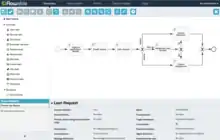 Example of editing a BPMN model in Flowable | |
| Developer(s) | Community |
|---|---|
| Stable release | |
| Repository | github |
| Written in | Java, JavaScript |
| Operating system | Linux, Windows |
| Type | Business process management, Workflow |
| Licence | Apache License 2.0 |
| Website | www |
Flowable is an open-source workflow engine written in Java that can execute business processes described in BPMN 2.0.[4] It is an actively maintained fork of Activiti (software).[5]
History
In October 2016, the lead developers of Activiti (software) left Alfresco (software) and started the Flowable Open Source project based on a fork of Activiti code.[6][7]
The first version of Flowable was 5.22, based on a fork of Activiti 5.21, but added Transient Variables.[8] The first release of Flowable version 6.0[9] was based on a fork of Activiti version 6 beta 4. Version 6 of the Flowable engine includes a rewrite of the core process virtual machine.
Components
The project comprises a set of modules that can operate together:
- BPMN Engine, the core Business Process Model and Notation workflow processor
- CMMN Engine, a Case Management Model and Notation processor
- DMN Engine, an implementation of a subset of Decision Model and Notation based business rules
- Flowable Design, a cloud-based graphical authoring interface for editing BPMN, CMMN, and DMN [10][11]
Differences between Version 5 and Version 6
The key changes in Flowable 6 are:[12][13]
- Abstract persistence layer, enabling use of relational or non-relational data sources[14][15]
- 1-to-1 mapping of BPMN model to executable instruction set
- Simplified execution tree, enabling easier analysis and manipulation of in-flight processes
- Single agenda for process execution plans
- Queue-based job execution[16]
- Ad hoc Sub Processes[17]
- Dynamic process execution[18]
References
- ↑ Flowable 7.0.0 downloads
- ↑ Flowable 6.8.0 downloads
- ↑ Flowable 5 downloads
- ↑ Joram Barrez (2016-10-17). "Announcing Flowable". Small steps with big feet. Retrieved 2016-12-29.
- ↑ Jeff Potts (2016-10-15). "Activiti founders fork the project to create Flowable, an open source BPM engine". Enterprise Architect. Retrieved 2016-12-29.
- ↑ Sandy Kemsley (2016-10-20). "Another rift in the open source BPM market: @FlowableBPM forks from @Alfresco Activiti". Enterprise Irregulars. Retrieved 2016-10-20.
- ↑ Flowable Team (2016-10-12). "Flowable and Activiti: What the Fork?!". Flowable. Archived from the original on 2016-12-30. Retrieved 2016-10-20.
- ↑ Joram Barrez (2016-09-01). "How to use transient variables". Small steps with big feet. Retrieved 2017-01-03.
- ↑ Flowable Team (2017-02-15). "Flowable 6.0.0 release". Flowable Project. Retrieved 2017-02-26.
- ↑ Tijs Rademakers (2023-04-13). "New Flowable Modeling tool". Flowable Forum. Retrieved 2023-09-21.
- ↑ Valentin Zickner (2023-06-20). "Unveiling the new Flowable Design: A closer Look". Flowable Blog. Retrieved 2023-09-21.
- ↑ Tijs Rademakers (2016-08-31). "Activiti 6.0.0.Beta3 released". BPMN 2.0 / Flowable. Retrieved 2017-01-03.
- ↑ Joram Barrez (2015-09-08). "An Evolution of the Core Engine". Small steps with big feet. Retrieved 2016-12-29.
- ↑ Joram Barrez (2016-11-02). "Running Flowable on CockroachDB". Small steps with big feet. Retrieved 2016-12-29.
- ↑ Joram Barrez (2018-08-13). "Running Flowable on MongoDB". Flowable Blog. Retrieved 2018-08-13.
- ↑ Joram Barrez (2016-07-20). "Benchmarking the message queue based Activiti Async Executor". Small steps with big feet. Retrieved 2017-01-03.
- ↑ Tijs Rademakers (2016-02-10). "Activiti 6 adds ad-hoc sub process support". BPMN 2.0 / Flowable. Retrieved 2017-01-03.
- ↑ Paul Holmes-Higgin (2017-04-20). "BPMNext 2017: Making Business Processes Dance". BPMNext. Retrieved 2017-05-09.
This article is issued from Wikipedia. The text is licensed under Creative Commons - Attribution - Sharealike. Additional terms may apply for the media files.